



Variations in Calumma brevicornis
By Christopher V. Anderson
Citation:
Anderson, C.V. (2002). Variations in Calumma brevicornis. Chameleons! Online E-Zine, September 2002. (http://www.chameleonnews.com/02SepAnderson.html)
Calumma b. brevicornis is described as a chameleon from the Eastern and Northern portion of Madagascar with a single, rigid rostral appendage and large, distinct occipital lobes. These occipital lobes are generally covered in large scales and are "separated by a notch behind the occiput" (Glaw and Vences, 242) (Photo 1). Additionally, it is noted that all specimens have a dorsal crest, although, it may be weakly defined. This stated, however, there seem to be large variations within this species which could, as Glaw and Vences suggested, serve to indicate that this species in fact represents a larger species complex. They noted the variation in specimen size from different localities, the size differences of the dorsal crest, the differences in patterning and the variations in the occipital lobes and in the rostral protuberance.

Photo 1
While visiting Madagascar, I was privileged enough to have come across specimens of C. b. brevicornis in many different areas as well as some captive specimens. During this time, the vast assortment of variations in this species became very evident and sparked curiosity. Animal size is a variation that, without intensive field collection within each given locality, could not stand up as proof of a statement of this species vast variability. Therefore, with my observations being as limited as they were in each area, I have not considered this to be a factor in my observations. Similarly, I have tried to factor out natural dimorphic differences between sexes and, as such, have chosen to ignore the size of the rostral process and occipital lobes. Rather, I have attempted to stick more toward basic morphological differences and obvious pattern variations, while keeping in mind sexual dimorphisms in the patterns. Using these criteria, I have still noted a large variation.
Before discussing the variations that I noted, it is important to provide descriptions of similar species and distinguish between the subspecies. The subspecies Calumma brevicornis tsarafidyi was separated from the nominate form in 1970 based on a single male specimen that was captured in the Tsarafidy forest, for which it was named (Glaw and Vences). This classification was based primarily on the fact that the occipital lobes of this specimen were significantly smaller and clearly consisting of two sections while the nominate Calumma brevicornis brevicornis had much larger occipital lobes which are merely separated by the previously mentioned notch. Additionally, Martin indicates that C. b. tsarafidyi does not have a parietal crest while C. b. brevicornis has a very distinct one. Calumma hilleniusi (Photo 2), once described as Calumma brevicornis hilleniusi, is considerably smaller than C. b. brevicornis and, as Glaw and Vences point out, all specimens are generally green. Additionally, the occipital lobes are clearly separated, not even touching in fact, which they do in C. b. brevicornis. It is important to note that Glaw and Vences claimed to have never observed a green C. b. brevicornis. Finally, Calumma malthe (Photo 3) is distinguished by the fused occipital lobes and small scalation on the lobes rather than the large scales on the lobes of C. b. brevicornis. Additionally, the occipital lobes of C. malthe often have green edges. A typical, if there is such a thing, C. b. brevicornis (Photo 4) is about 10-12 inches (25-31 cm) total length, with a reddish-brown or drab coloration.
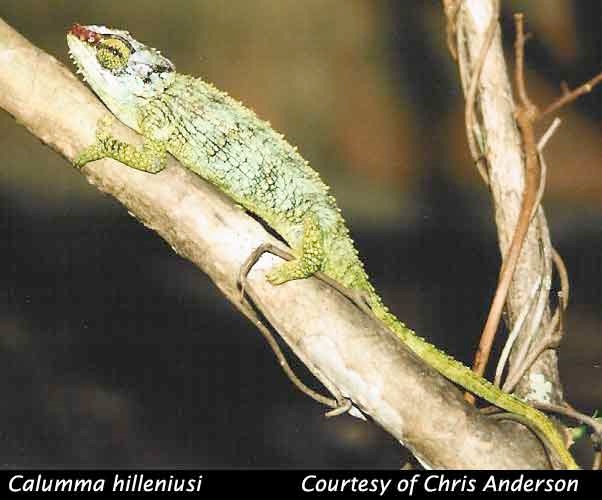
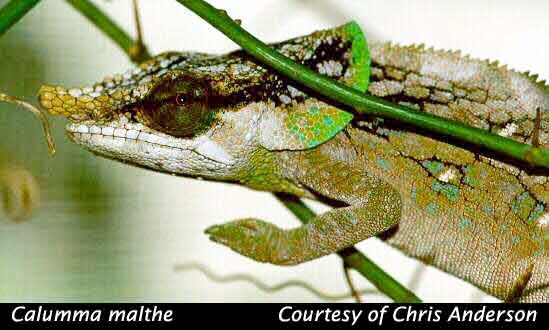
Photo 2
Photo 3

Photo 4
While in Analamazaotra, or Perinet Special Reserve, one of these typical animals (Photo 5) was found right in front of our bungalow. Upon further inspection, one can see that this female has no ventral or gular crests (Photo 6). Her patterning and coloration did fit a typical description of this species. Unfortunately, my notes and photographs of other specimens from this region do not indicate existence of either crest.

Photo 5

Photo 6
Later, while at La Mandraka, a local, private-owned zoo, I was able to observe a number of other interesting specimens although no information about what area these animals were collected from was available. My first applicable observation of these animals was on another female which seemed to match a typical description much like that of the female previously mentioned from Perinet. In most respects, this animal appeared very similar except for the fact that this female did in fact have a developed gular and ventral crest (Photo 7). I then observed another female that, once again, looked very similar to the two previously mentioned specimens and noted that this animal, like the first from Perinet, did not have either a gular or ventral crest (Photo 8). After observing a number of other animals and determining that some had neither and other had both crest, my curiosity as to why there was an existence of such a large morphological difference increased. Examination of males showed similar findings but also sparked interest in the differences in patterning and coloration in the males. One male (Photo 9), which did not have either a gular or ventral crest, had reddish brown head scales, a largely drab body and bluish green scales on the limbs. Another male wish similar but more intense coloration and patterning did not have these crests either (Photo 10). A final male at La Mandraka did have both a gular and ventral crest but had significantly different coloration and patterning. This male (Photo 11) was largely a gray-white coloration with a reddish rostrum and a lot of light blue on the head. Additionally this male was much larger bodied and a couple inches longer than the other adult males that were observed throughout my travels.

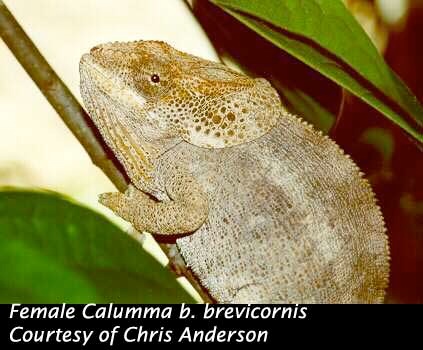
Photo 7
Photo 8

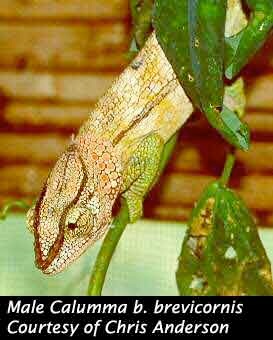
Photo 9
Photo 10
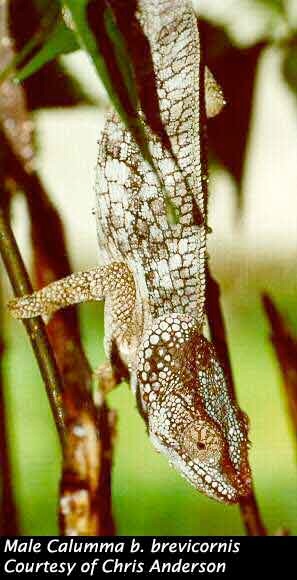
Photo 11
In the Mandraka forests about 5 km away from the zoo La Mandraka, a wild male was found with similar coloration and patterns to two of the males in the zoo. This male (Photo 12) had a body with mixed drab colors and blue scales on the limbs and ventral area. Unlike one of the two similar animals at La Mandraka, this animal did have both a dorsal and ventral crest. A second, immature male (Photo 13) was found nearby. This animal was more typically drab colored with a red, already well formed rostral protuberance. It is possible however that this specimen had simply yet to grow into its adult coloration as seen in the adult male found nearby. It is interesting to note that Glaw and Vences record specimens from this region as Calumma cf. brevicornis. This signifies an acknowledgement of their variation so that if in the future they are described as separate, the author(s) can be seen as having known and pointed out the obvious differences.
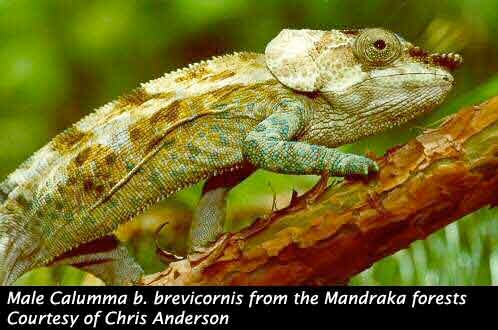
Photo 12
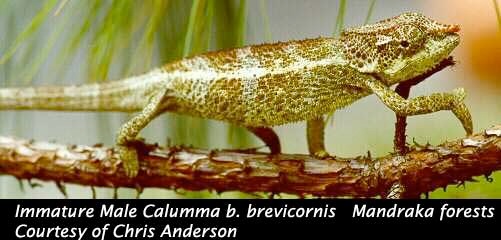
Photo 13
Finally, later in the trip, in Montagne D'Ambre National Park, another variation of C. b. brevicornis was found. Two variations of note were made while visiting this park. First, the males of this area all (Photo 14) seemed to have both gular and ventral crests and have a very drab and consistent color and pattern. Additionally, the females (as shown on Adcham.com) were a light green color with no drab coloration. This contradicts Glaw and Vences reports of having never observed green C. b. brevicornis.

Photo 14
In conclusion, these observations showed there to be a significant variation in coloration, patterning and morphological features in Calumma brevicornis brevicornis in the forests of Eastern and Northern Madagascar. This species likely does represent a larger species complex and is most definitely worthy of further study and possible reclassification in the future.
References:
Glaw, F. and M. Vences, A Fieldguide to the Amphibians and Reptiles of Madagascar,
Second Edition. M Vences & F. Glaw Verlags GbR, Germany: 1994.
Martin, J., Masters of Disguise: A Natural History of Chameleons. Facts On File, Inc.,
New York, NY: 1992.
Necas, P., Chameleons: Nature's Hidden Jewels. Krieger Publishing Company,
Malabar, FL: 1999.

Christopher V. Anderson
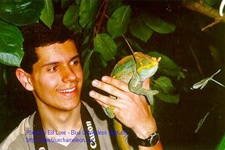
Chris Anderson is a herpetologist currently working on his Ph.D. at the University of South Florida after receiving his B.S. from Cornell University. He has spent time in the jungles of South East Asia, among other areas, aiding in research for publication. He has previously traveled throughout Madagascar in search of, and conducting personal research on, the chameleons of the region. He has traveled to over 35 countries, including chameleon habitat in 6. Currently, Chris is the Editor and Webmaster of the Chameleons! Online E-Zine and is studying the kinematics and morphological basis of ballistic tongue projection and tongue retraction in chameleons for his dissertation. Chris Can be emailed at Chris.Anderson@chameleonnews.com or cvanders@mail.usf.edu.









Join Our Facebook Page for Updates on New Issues:
© 2002-2014 Chameleonnews.com All rights reserved.
Reproduction in whole or part expressly forbidden without permission from the publisher. For permission, please contact the editor at editor@chameleonnews.com
